The Temple abode of Malur Sri Raja Balambika...
Key insight into Balambika Temple
As a humble attempt to reciprocate Her infinite
grace and unparalleled mercy, and keeping up with the age-old Hindu tradition of
building temples, Balambika Divya Sangam started construction on a magnificent
temple for Sri Balambika at Malur in 2011, with Kumbhabhishekam scheduled for
April 10th, 2017. Situated around 50 kms from
Bengaluru, the town of Malur or
Malligepura is blessed with plentiful water, beautiful landscapes,
and lush greenery. With the aromatic scent of eucalyptus groves and
mallige flowers permeating the air, Malur truly seems to furnish
the perfect environment for a tranquil and spiritually uplifting experience.

Artistic illustration of Sri Malur Balmbika Temple
Inspired by the exquisite Chola Dravidian style of temple architecture, the Malur Balambika temple would serve as a beatific abode for Sri Bala, that devotees from all walks of life could visit, to invigorate their spiritual energy. In addition to being a treasure trove of intricate art and design, the temple would also serve as the administrative hub for a multitude of socio-economic outreach activities of the Sangam, many of which already are in full swing in Malur.
Sri Balambika temple at Malur derives inspiration
from the Gangaikonda Cholapuram temple. Constructed over an area of 12000
sq.ft., it is a rectangular-shaped structural temple that generously applies the
archaic and well-chronicled Chola-Dravidian style of temple architecture. Apart
from a few sections and the Vimanam built from sudai (cement), the
rest of the temple is constructed wholly in stone, exhibiting an architectural
grandeur that would leave anyone astounded. The Sthala Vruksham of
this temple is the Kadamba tree, as
‘Kadamba vana Vasini’ is one of Ambal’s innumerable epithets.
At the entrance, we are greeted by Dwajasthambam.
The Dwajasthambam is referred to as being a medium for the Heavens
to be connected to the earth, which would refer to it being a spiritual
connector between us earthlings, and the Supreme Being - God.The Sanskrit word
for the flag is ‘dhvaja’ and it means whatever is raised. In the
religious sense, whatever raises man to a higher level of understanding and
activity is a ‘dhvaja.’ The flag also suggests hope and desire to overcome
ignorance. Dwajasthambam gives an idea to a devotee from a long distance about
the idol installed in the temple. A Dwajasthambam usually represents the
prosperity and pride of a temple.
"Garba Gruha Sirahapoktam antaraalam Galamthatha
Viswakaramyam Vaasthu Sastra
Ardha Mandapam Hridayasthanam Kuchisthanam Mandapomahan
Medhrasthaneshu Dwajasthambam Praakaram Janjuangeecha
Gopuram Paadayosketha Paadasya Angula Pokthaha
Gopuram Sthupasthatha Yevam Devaalayam angamuchyathe"
It can be noticed that the top of the DhwajaStambha is the highest point of the
temple, and thus, whenever lightning would strike, the temple would be saved
from the devastating damage that could have been caused. This is what could be
meant from the explanation that it connects "Heaven to
Earth" (i.e.) it conducts the charges from the clouds above during
lightning to earth or ground, which is the electrical term for a no-potential
area. Dwajastambham is a kind of Antenna like structure which receives the
cosmic rays and brings it down to the premise of temple. As you stand in front
of the dwajasthambam, the four sides of the pillar catches your eye , each side
has the sakthi parivar namely, Siddhi
Vinayaka, facing the main entrance on the east and facing west is
Murugan and on the north and southern side we
have Parvathy and Shiva in the form of lingam.
Moving forward you see the Vimanam which is holds the kalasam
of the temple. The Vimana in the South Indian temple history
had an interesting career. For instance, the most magnificent Vimana of the
Raja-rajeshwara temple at Tanjavur (1009 AD) rises to an imposing height of
58 meters. Another temple of the same period at Gangaikonda-chola-puram
(1025 AD) rises to a height of 48 meters. Thereafter, in the subsequent
periods, the Vimanas tended to grow shorter. But the Gopuras, the towers
that stand over the gate-ways (dwara-gopura) became
increasingly ornate, complicated and huge. While the temple complex is
designed as a Mandala with the sanctum at its heart
(Brahma –sthana); the sanctum along with the Vimana atop is
itself regarded a Mandala. The image is located in the mid-point of the
sanctum which is designed as a square; that is, where its diagonals
intersect each other. This point is elevated, in a three dimensional
projection, and rendered as the sthupi or the central point of
the Vimana. The Kalasha is installed at this point.
We believe that the universe features a cyclic nature of creations and
destructions and since the temple represents the universe, it had to embody
the cyclical notion. For that reason a pattern of growth is added. This
pattern grows from unity to multiplicity, simultaneously tending back to
unity through a process of dissolution and fusion.

Vimana
The sthambavargam is adorned with exquisite ornamentation on
all faces, with an artistic interplay of figures of concentric circles,
hamsams (swans), and floral abstracts, in a unique alternate
arrangement. The roof of the mahamantapam adds its finishing touch to this
artistic opulence, with ornate padams carved in stone. Apart from the main
doorway, the mahamantapam can be accessed from entrances in the north and
south. A flight of steps with yali (mythical creature seen in
many Hindu temples, which is part elephant and part horse) sculpted onto it,
opens into the praharam, or circumambulatory path.
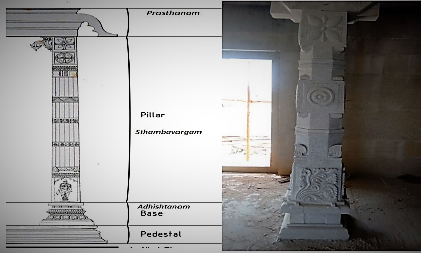
Illustration compared with the actual
The mahamantapam paves the way into the
ardhamantapam, which eventually leads to the
inner sanctum sanctorum or garbhagruham.
Above the doorway of the ardhamantapam is the
mugappu thotram (bracket figure) of Sri
Gajalakshmi, seated in a padmasana posture and
bestowing materialistic and spiritual wealth and prosperity. The entrance of
the ardhamantapam is closely guarded by two female
dwarapalakas, Varahi Devi and
Raja Shyamala on either side. As outlined in
Sri Lalitha Sahasranamam, Lalitha Devi was helped by Her Prime Minister Raja
Shyamala, and Chief of army Varahi Devi, in the legendary war against the
demon Bhandasura.
Traversing through the mahamantapam towards
the garbhagruham is a spiritually uplifting experience, as one gets the
first glimpse of the main deity, Sri Balambika, majestically standing on an
upapeetam in a regal stance as Raja Bala. connection between atma and
paramatma remains, reminding oneself of Her unparalleled grace and
unconditional love. Another remarkable feature of this temple, is the
Ardha Bimbam of Sri Raja Rajeshwari, the Universal Mother, on
the western wall of the garbhagruham, facing east. The sight of Sri Raja
Rajeshwari and Her child-like form Sri Balambika giving darshan together,
makes one feel that their spiritual journey is consummate.
Sri Bala Tripura Sundari (moolavar)
In chapter 26 of the
Lalitā Māhātmya, Bala
Tripurasundari joins the battle with Lalithambal to fight the forces of the arch-demon
Bhaņḍa. This scene is now recreated in our temple. Lalithambal as Rajeswari
behind Bala sitting there admiring her daughter fight the sons of Bhanda. On
hearing that the sons of Daitya Bhaņḑa, the
chief of whom was Caturbāhu stood against the Lalithambal for
the purpose of fighting, Bālā came from the golden
kavasa of Lalita. She always stayed near the goddess. She is a
warrior and an expert in martial arts and warfare. Her form and features are
like those of Lalitā. She is always like a nine-year-od girl,
yet she was great and all powerful. Her body was like the rising sun. Her
creeper-like slender body was red in complexion. She is the vital breath of
the goddess moving externally. She was Lalithambal’s fourth eye.
She became furious when bhanda conforted her Mother and thought thus:
"I shall immediately kill those sons of Bhanda who have come here"
.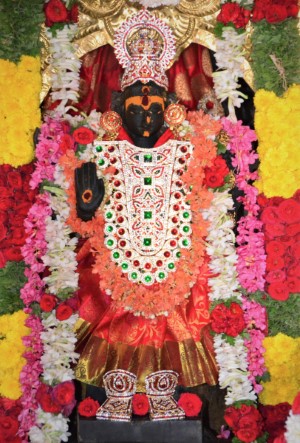
Raja Balambika
After making up her mind Bālāmbā submitted to the great queen.
"Mother, the sons of Bhaņḑa, the great Daitya,
have come to fight. I wish to fight with them. I am interested in
this because I am a young girl. My arms throb with an itching
sensation for war. This is my playful activity. It should not be
curbed by your orders for prohibition. Indeed I am a girl loving
toys and playful pastimes. By this play of fighting for a moment, I
shall become delighted mentally."
"Dear child, your limbs are very tender and
soft. You are only nine years old. This is your first step and
performance. Your training in warfare is fresh and recent. You are
my only daughter. Without you, my breathing activity does not go on
even for a moment. You are my very vital breath. Do not go in for
the great war. We have Daņḑinī, Mantriņī and crores of other great
Śaktis for fighting. Dear child, why do you want to do this
now?"
Śri Lalitādevī, became curious so when Balamba requested once
again for permission to fight, she said “Yes” clasping her in her arms. She
took off one of her armours and gave it to her. From her weapons, she gave
her the requisite weapons and sent her off. Kūmārikā got into
the covered palanquin that had been extracted by the great queen from the
staff of her bow and to which hundreds of swans were yoked for drawing. She
killed all 30 sons of the demon Bhandasura which was extremely difficult to
do.
Varahi, the Army Chief
Outside the garbhagraham and in
the mahamandapam, at the edge of the chariot which holds Lalithambal and Balamba are Varahi and Raja Shamala. Her face
resembling a boar is dark or storm-cloud colored. She wears
Karanda-Makuta on her head and is adorned with ornaments made
of corals. She wears Nupura on her ankles. She has a big belly
and has four hands, in two of which she carries the changu and
chakra; the remaining two hands being respectively held in the
Abhaya and Varada poses. The
Purvakaranagama says that she carries
the,Saringapdhanus, the Hala and
Musala as her weapons. Her Vahana as well as the
emblem on her banner is the elephant. She sits there welcoming Balamba’s
devotees, waiting to shower her blessings and boons on them all.
Varahi is described in many of the puranas:
Devi Mahatmya that deals with the killing of the demon Raktabija, says that the warrior-goddess Durga
creates the Matrikas from herself, and Varahi being one of them
and with their help slaughters the demon army. When the demon Shumbha challenges Durga to single combat, she
absorbs the Matrikas into herself.
In the Vamana Purana, the Matrikas arise from different parts
of the Divine Mother Chandika; Varahi arises from Chandika's back. In the
slaying of Raktabija, Varahi is also referred to as the Shakti of Hari, who
assumed the incomparable form in a sacrificial boar and also assumed a
boar-like form.
The Markendeya Purana praises Varahi as a granter of boons and the regent of the northern direction, in a hymn where the Matrikas (forms of Sakthis) are declared as the protectors of the directions. The Devi Bhagavata Purana praises Varahi, who assists the Supreme Mother to fight demons when needed.
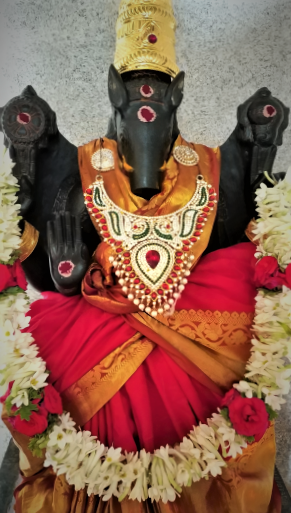
Varahi
Raja Shyamala, the Prime Minister
Raja Shyamala is also referred to as Raja
Matangi. She is the Goddess of Knowledge, Talent and Expertise. In their
meditative state, ancient rishis provided various paths to reach the Supreme
Divine. They gave particular forms and mantras to identify particular
aspects of the Divine Mother. Supreme Cosmic Consciousness manifests in the
material world as various saguna deities.
She is the consort of Lord Shiva and she is also considered as the sister of
Lord Vishnu. She connects the phenomenal world with that of the noumenal
world and its experiences. This paves the way to break through the cycle of
birth and rebirth. Mother gives wisdom as prasada to for us to connect with
her Divinity. Human kind, having descended to the material world, revere
Goddess Raja Mathangi for her blessings to realize the return journey and
yoga with Divine mother.
Raja Mathangi is the Goddess presiding over
Manifestation. Through her, thought becomes ‘word, unmanifest ‘sound and
vibration’ becomes music and ideas unfold into expression. Divine
Consciousness becomes the created Universe. Raja Mathangi is the highest of
the Goddesses in that She allows all their powers and principles to be
realized.
Goddess Raja Matangi is often represented as emerald green in colour or
‘syama varnam’; the color of depth of knowledge and profound
life energy. While Ucchishta-Matangini carries a noose, sword, goad, and
club, her other well-known form Goddess Raja Matangi, plays the veena. Also
Mother Raja Matangi is said to have stood before Mathanga Maharishihka with
her twelve hands in a ferocious form to spread her greatness all over the
universe. She is seen playing the veena and with a beautiful green parrot.
Raja Matangi is also said to be the manifestation of Goddess Meenakshi of
Madurai.
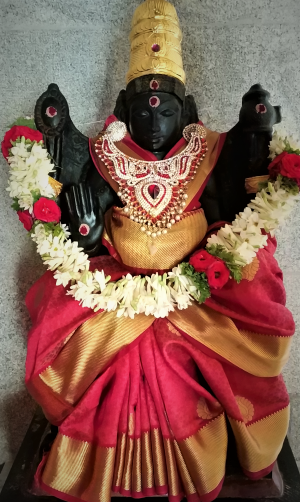
Raja Shyamala
Raja Rajeswari, the Mother
Raja Rajeswari is the presiding deity of Sri
Chakra, she is also the mother of love and grace. She is the personification
of the Divine desire to create the universe and also the Divine desire to
merge the creation back into the ultimate Brahman (God the
father). This two fold desire is the basis of love, the vivifying bond that
ties the Creator and the created. She controls our minds and sensory organs
and holds the key to transcendental knowledge. She resides on the top of the
head (Sahasrara), and also in the second chakra
(Swadisthana).
She has four hands and three eyes. She wields in her four hands the noose,
the goad, sugar cane bow, and five flowered arrows. Her three eyes are Sun,
Moon and Fire representing the three triads in creation. Her crown is
decorated with the crescent moon the symbol of divine delight. The noose
represents strong determination and love by which She binds the whole
creation. The goad is the symbol of the power of knowledge, it is the wrath
of fiery emotions by which the whole creation is spurred into activity. The
sugar cane stem depicts the mind principle of man. The five flowered arrows
are the five tanmatras, sound, touch, form, taste and smell - the source of
the five elements.
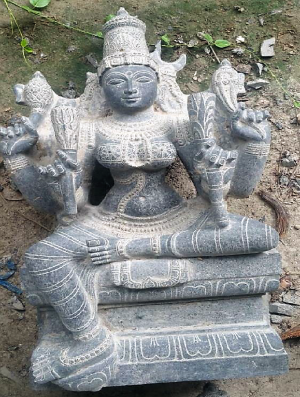
Raja Rajeswari
She has three forms, the gross physical form (sthula sharira),
subtle astral form, (sukshma sharira) and the causal archetypal
form of the macrocosm and microcosmic creation.
When She is meditated upon, this ultimate energy, in the first and second
chakra (Muladhara and Swadhisthana) the sadhaka
(spiritual aspirant) is performing internal fire sacrifice. She emerges out
of the lotus chakras as Kundalini the supreme
power elevating the sadhaka.
The graceful Mother removes evil and develops goodness within all of us.
She is the power of Brahman; pure consciousness embodied. She is the bliss
of "Sat - Chit - Ananda"
existence, knowledge and bliss.











